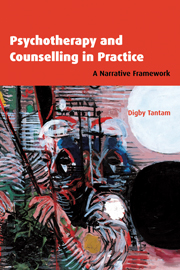Book contents
- Frontmatter
- Contents
- Preface
- A note on terminology
- Acknowledgements
- Introduction
- 1 Establishing the concerns
- 2 Values
- 3 What life means. Emotional flavour
- 4 Narrating the treatment: the formulation, reformulation and therapeutic contract
- 5 Narrating the self
- 6 Procedures for gaining relief
- 7 Resolution: finding out what's doing this to me
- 8 Universal technique for resolving predicaments
- 9 Relinquishment and releasement: changing something about me
- 10 Re-narration: finding happiness
- 11 Crises, and how to surmount them
- Appendix: confidential record
- References
- Index
7 - Resolution: finding out what's doing this to me
Published online by Cambridge University Press: 06 November 2009
- Frontmatter
- Contents
- Preface
- A note on terminology
- Acknowledgements
- Introduction
- 1 Establishing the concerns
- 2 Values
- 3 What life means. Emotional flavour
- 4 Narrating the treatment: the formulation, reformulation and therapeutic contract
- 5 Narrating the self
- 6 Procedures for gaining relief
- 7 Resolution: finding out what's doing this to me
- 8 Universal technique for resolving predicaments
- 9 Relinquishment and releasement: changing something about me
- 10 Re-narration: finding happiness
- 11 Crises, and how to surmount them
- Appendix: confidential record
- References
- Index
Summary
In the previous chapter, persistent and disabling emotion was considered from the point of view of the client who found it useful to consider it to be an emotional malfunction or the consequence of a habit. The treatment approaches considered in that chapter had many values in common with medical practice. Indeed, many practitioners combine these approaches with drug treatments. These shared values include attributing problems to illness or pathology rather than to personal agency, emphasizing the causes rather than the reasons for things, and minimizing responsibility for anything but being a good client. Additional values inherent in symptomatic and motivational approaches include social cooperation, and the priority of the future over the past. Family members, if they are involved, are recruited as therapeutic assistants and they, and the therapist, are seen as helpers. Whatever has happened in the past, there is optimism and potential relief or change in the future.
The symptom-relieving approaches considered in Chapter 6 assumed that neither past emotional experiences nor current interpersonal conflict was relevant to the therapy. If we wanted to use metaphors of emotional flavour, we could say that symptom-relieving approaches are sweet rather than salty (if conflict is the salt), and sour rather than bitter (if the past is the gall).
Many people, including many therapists, consider that a psychotherapeutic approach that takes no account of interpersonal conflict is too saccharine, and that the past must be faced, however bitter it might be.
- Type
- Chapter
- Information
- Psychotherapy and Counselling in PracticeA Narrative Framework, pp. 165 - 192Publisher: Cambridge University PressPrint publication year: 2002



